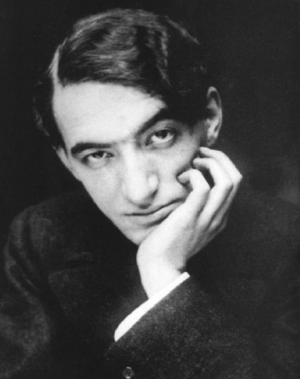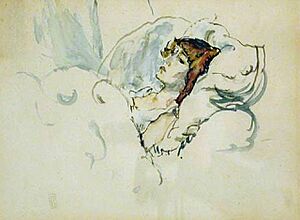Jules Pascin facts for kids
Quick facts for kids
Jules Pascin
|
|
|---|---|
 |
|
| Born | March 31, 1885 Vidin, Bulgaria
|
| Died | June 5, 1930 (aged 45) Paris, France
|
| Resting place | cimetière du Montparnasse |
| Nationality | America, French, Bulgarian |
| Education | Drawing in Vienna, Moritz Heymann's academy in Munich, Matisse Academy and Académie Colarossi in Paris |
| Movement | École de Paris, Expressionism |
| Spouse(s) | Hermine David |
| Partner(s) | Lucy Krohg |
Julius Mordecai Pincas (March 31, 1885 – June 5, 1930), known as Pascin (pronounced [pas.kin]; erroneously French: [pas.kɛ̃] or [pa.sɛ̃]), Jules Pascin, also known as the "Prince of Montparnasse", was a Bulgarian artist of the School of Paris, known for his paintings and drawings. He later became an American citizen. His most frequent subject was women, depicted in casual poses.
Pascin was educated in Vienna and Munich. He traveled for a time in the United States, spending most of his time in the South. He is best known as a Parisian painter, who associated with the artistic circles of Montparnasse, and was one of the emigres of the School of Paris. Having struggled with depression, he died at the age of 45.
Contents
Early life
Julius Mordecai Pincas was born in Vidin, Bulgaria, the eighth of eleven children, to the Sephardic Jewish family of a grain merchant named Marcus Pincas. Originally from Ruse, the Pincas family was one of the wealthiest in Vidin; they bought and exported wheat, rice, maize and sunflower. His mother, Sofie (Sophie) Pincas, belonged to a Sephardic family, Russo, which had moved from Trieste to Zemun, where she and her husband lived before moving to Vidin and where their older children were born.
The family spoke Judaeo-Spanish at home. In 1892, he moved with his parents to Bucharest, where his father opened a grain company, "Marcus Pincas & Co". Pascin worked briefly for his father's firm at the age of fifteen. His first artistic training was in Vienna in 1902 at age seventeen. In 1903 he relocated to Munich, where he studied at Moritz Heymann's academy. There he got in touch with Paul Klee, Alfred Kubin and Wassily Kandinsky. In 1905 he began contributing drawings to Simplicissimus, a satirical magazine published in Munich. Because his father objected to the family name being associated with these drawings, the 20-year-old artist adopted the pseudonym Pascin (an anagram of Pincas) with his father's permission. He continued to contribute drawings to a Munich daily until 1929.
Paris
In December 1905, Pascin moved to Paris, becoming part of the great migration of artists to that city at the start of the 20th century. There he was welcome by "Les Dômiers" the regular customers of Cafe le Dome. The Dômiers introduced Pascin to Hermaine David In 1907, also a painter and at the time a student in the Académie Julian and student of Jean-Paul Laurens, the two became lovers. In that same year he had his first solo exhibition at Paul Cassirer Gallery in Berlin. Despite his social life, Pascin created thousands of watercolors and sketches, plus drawings and caricatures that he sold to various newspapers and magazines. In 1908, Pascin began to study in the Matisse Academy. Pascin would visit the Louvre, taking a special interest in the masters of the 18th century especially Greuze, Boucher, Watteau and Fragonard.
He exhibited his works in commercial galleries and in the Salon d'Automne, the Salon des Indépendants, and the exhibitions of the Berlin Secession and at the Sonderbund-Ausstellung in Cologne. Between 1905 and 1914 he exhibited drawings, watercolors, and prints, but rarely paintings. It was not until about 1907–1909 that he produced his first paintings, which were influenced by Fauvism and Cézanne. He wanted to become a serious painter, but in time he became deeply depressed over his inability to achieve critical success with his efforts. Dissatisfied with his slow progress in the new medium, he studied the art of drawing at the Académie Colarossi, and painted copies after the masters in the Louvre. He exhibited in the United States for the first time in 1913, when twelve of his works were shown at the Armory Show in New York.
Pascin relocated to London at the outbreak of World War I to avoid service in the Bulgarian army and left for the United States on October 3, 1914. On October 31, Hermine David sailed for the United States to join him.
United States
Pascin and David lived in the United States from 1914 to 1920, sitting out World War I. They visited New York City, where David had an exhibit. Pascin frequented nightclubs, and met artists such as Yasuo Kuniyoshi, Gaston Lachaise and Guy Pène du Bois, but most of his time in America was spent traveling throughout the South. He also visited Cuba. He made many drawings of street life in Charleston, New Orleans, and other places he visited. Some of his works of 1915 and 1916 are in a Cubist style, which he soon abandoned.
In 1918 Pascin married Hermine David at City Hall in New York City. Their witnesses were Max Weber and Maurice Sterne, friends and painters who both lived in New York. In September 1920, Pascin became a naturalized United States citizen, with support from Alfred Stieglitz and Maurice Sterne, but returned to Paris soon afterward. There he began a relationship with Lucy Vidil Krohg, who had been his lover ten years earlier but had married the Norwegian painter Per Krohg during Pascin's years in America.
Especially after he returned to France, he became the symbol of the Montparnasse artistic community and is more associated with France than the United States. Always in his bowler hat, he was a witty presence, along with his good friend Constant Detré, at Le Dôme Café, Jockey-Club de Paris, and the other haunts of the area's bohemian society. Pascin visited Bulgaria in 1923 and 1924 and at an uncertain later date.
Career
Like Henri de Toulouse-Lautrec, Pascin drew upon his surroundings and his friends, both male and female, as subjects. Famous as the host of numerous large parties in his flat, whenever he was invited elsewhere for dinner, he arrived with as many bottles of wine as he could carry. He frequently led a large group of friends on summer picnics beside the river Marne, where their excursions lasted all afternoon.
Among Pascin's circle of Parisian friends was Ernest Hemingway, whose memoir A Moveable Feast includes a chapter titled "With Pascin At the Dôme", which recounts a night in 1923 when he met Pascin and two of his young models for drinks at the café.
His fellow artist friends and contemporaries included: Chaim Soutine, Isaac Frenkel Frenel, Michel Kikoine and other Jewish artists of the School Of Paris.
Style
His experience as a satirical draftsman and his knowledge of German expressionism are evident in his early works, where some portraits evoke Otto Dix or Grosz with a less incisive and less cruel touch. He quickly evolved towards pastel-like, almost unreal colors that he skillfully harmonized with the theme of the female body, the center of his production.
His vibrant graphic style, with lines that only vaguely outline the contours of the body, allowed him to depict his models bathed in a light that reflects more a state of mind than the reality of a body. In this regard, he can be seen as an unsparing continuator of the 18th-century masters and their taste for freedom and libertinage.

Death
For years Pascin struggled with depression. He died at the age of 45 on the eve of a prestigious solo show. In his last will and testament, Pascin split his estate equally between his wife, Hermine David, and Lucy Krohg.
On the day of Pascin's funeral, June 7, 1930, thousands of acquaintances from the artistic community, and dozens of waiters and bartenders from the restaurants and saloons Pascin had frequented, all dressed in black, walked behind his coffin for three miles, from his studio at 36 boulevard de Clichy to the Cimetière de Saint-Ouen. A year later, Pascin's family had his remains re-interred at the more prestigious cimetière du Montparnasse.
Honours
Pascin Point in Antarctica is named after Jules Pascin.
In 2023, the former synagogue in Pascin's birthplace was reopened as the Jules Pascin Cultural Centre.
See also
 In Spanish: Jules Pascin para niños
In Spanish: Jules Pascin para niños
- Chaim Soutine
- Isaac Frenkel Frenel
- Marc Chagall
- Amadeo Modigliani
- School of Paris



